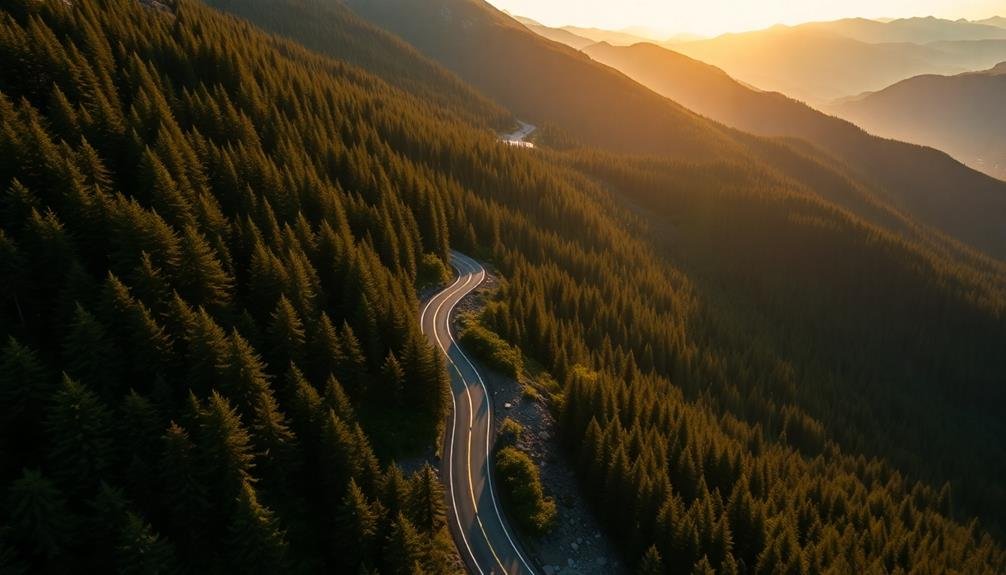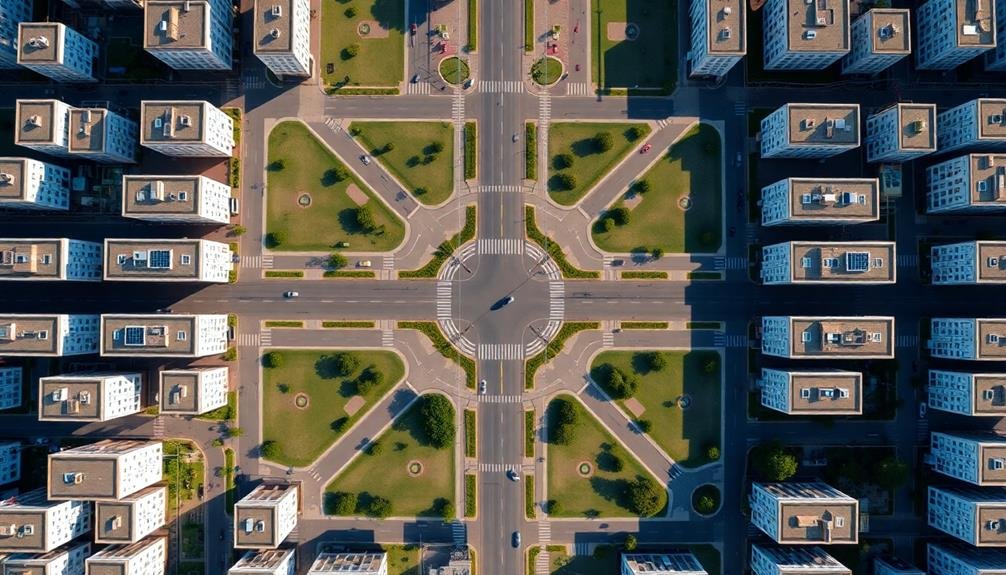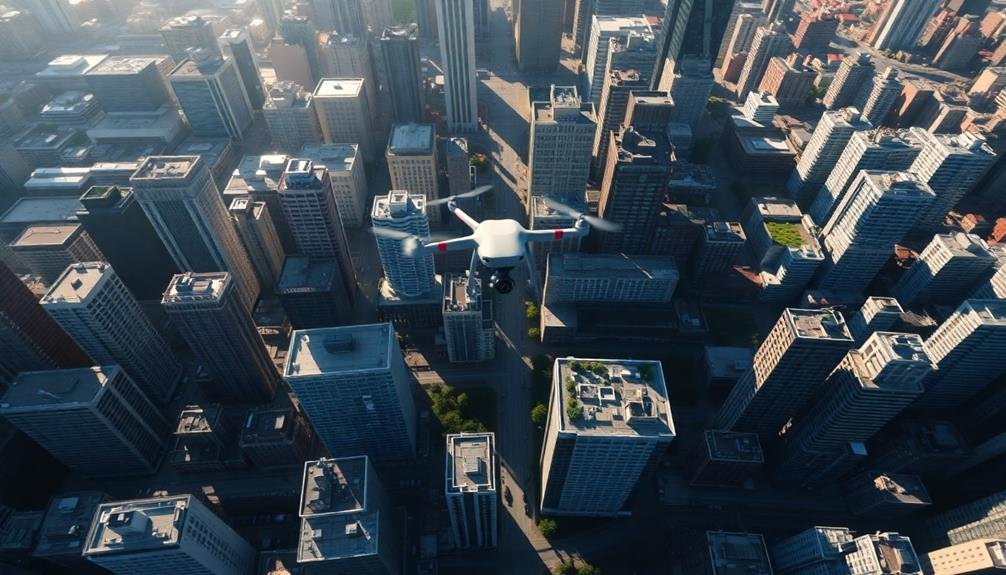Elevate your aerial photography with these five powerful storytelling techniques. Use leading lines like rivers and roads to guide viewers through your composition. Seek out symmetry and patterns in landscapes and urban grids to create balance and intrigue. Play with juxtaposition of scale to convey powerful messages about size and perspective. Harness dynamic shadows and light to add depth and drama to your shots. Finally, embrace negative space to isolate subjects and emphasize scale in your drone footage. By mastering these techniques, you'll create enthralling aerial compositions that draw viewers in and tell compelling visual stories. Explore further to reveal the full potential of your aerial imagery.
Key Takeaways
- Utilize leading lines from roads, rivers, or coastlines to guide the viewer's eye and create a sense of journey.
- Incorporate symmetry and patterns found in natural or urban landscapes to add balance and visual interest.
- Employ juxtaposition of scale by strategically positioning contrasting elements to convey powerful messages about size and perspective.
- Leverage dynamic shadows and light to enhance depth, drama, and texture in aerial compositions.
- Use negative space effectively to emphasize subjects, create isolation, and direct the viewer's attention in drone shots.
Leading Lines From Above

One of the most powerful techniques in aerial photography is the use of leading lines. From above, you'll discover an array of natural and man-made elements that can guide the viewer's eye through your composition. Rivers, roads, and coastlines become prominent features that draw attention and create a sense of depth.
When composing your shot, look for strong linear elements that stretch across the frame. These could be winding mountain trails, rows of crops in agricultural fields, or even the shadows cast by tall buildings. Position your drone to align these lines with key points of interest in your image.
You can use leading lines to create a sense of journey or destination. A meandering road disappearing into the horizon invites the viewer to imagine what lies beyond. Converging lines, like railway tracks or city streets, can draw focus to a specific subject or create a vanishing point.
Experiment with different angles and altitudes to emphasize these lines. Sometimes, flying lower can exaggerate the perspective, while higher altitudes might reveal patterns you hadn't noticed before.
Aerial Symmetry and Patterns

Two powerful compositional techniques in aerial photography are symmetry and patterns. When you're shooting from above, you'll often encounter natural and man-made structures that lend themselves to these approaches.
Symmetry creates balance and harmony in your images, drawing the viewer's eye to the center of the frame. Look for buildings, roads, or landscapes that mirror themselves across a central axis.
Patterns, on the other hand, can be found in repetitive elements like rows of crops, urban grids, or natural formations. They create rhythm and visual interest in your aerial shots. To capture effective patterns, you'll want to fly high enough to reveal the full extent of the repetition.
When composing your shot, consider how symmetry and patterns interact with other elements in the frame. Use them to guide the viewer's eye or to create contrast with asymmetrical features.
Experiment with different angles and altitudes to find the most compelling composition. Remember, subtle imperfections in symmetry or breaks in patterns can add intrigue to your images, creating focal points that tell a more engaging story from above.
Juxtaposition of Scale

While symmetry and patterns create visual harmony, aerial photography also offers a unique opportunity to explore contrasts in scale. You can use this technique to tell powerful stories by juxtaposing large and small elements within your frame. This approach helps viewers grasp the true magnitude of landscapes, structures, or events.
To effectively use juxtaposition of scale, you'll need to reflect on your altitude, lens choice, and composition carefully. Fly higher to capture vast areas, or lower to highlight smaller details. Wide-angle lenses emphasize the vastness, while telephoto lenses compress distances and create intriguing comparisons.
Here's a quick guide to juxtaposing scale in aerial photography:
| Subject | Large Scale | Small Scale |
|---|---|---|
| Natural | Mountains | Trees |
| Urban | Skyscrapers | Cars |
| Human | Crowds | Individuals |
When composing your shot, place contrasting elements strategically within the frame. You might position a tiny boat next to an enormous cruise ship or show a solitary hiker dwarfed by a sprawling desert landscape. These visual comparisons not only create engaging images but also convey powerful messages about our place in the world.
Dynamic Shadows and Light

Sunlight and shadows are powerful tools in aerial storytelling, creating depth, drama, and visual interest in your shots. As you capture aerial footage, pay attention to the interplay of light and shadow across landscapes and structures. Long shadows cast by early morning or late afternoon sun can add depth and texture to your compositions, highlighting the contours of terrain or urban landscapes.
You'll want to contemplate the direction of light when planning your shots. Side-lighting can emphasize textures and create dramatic contrasts, while backlighting can produce stunning silhouettes and rim lighting effects.
Don't shy away from incorporating lens flares or sun glares into your footage; when used judiciously, they can add warmth and atmosphere to your scenes.
Look for opportunities to capture dynamic shadow patterns, such as those created by passing clouds or the changing angles of sunlight throughout the day. These shifting patterns can introduce movement and life into otherwise static scenes.
Additionally, you can use shadows to frame subjects or guide the viewer's eye to specific areas of interest within your composition. By mastering the use of dynamic shadows and light, you'll elevate your aerial storytelling to new heights.
Negative Space in Drone Shots

Negative space plays a powerful role in aerial cinematography, complementing the dynamic use of light and shadow. When you're framing your drone shots, don't just focus on the subject; pay attention to the empty areas surrounding it. These spaces can create a sense of isolation, emphasize scale, or draw the viewer's eye to specific elements within the frame.
To effectively use negative space in your aerial compositions, consider these techniques:
| Technique | Purpose | Example |
|---|---|---|
| Isolation | Emphasize subject | Single tree in a field |
| Scale | Show size contrast | Tiny boat in vast ocean |
| Leading lines | Guide viewer's eye | Road cutting through desert |
| Symmetry | Create balance | Reflection in still lake |
Experiment with different altitudes and angles to maximize the impact of negative space. You'll find that higher altitudes often create more expansive negative spaces, while lower angles can use the sky as a blank canvas. Remember, negative space isn't just empty; it's an active element in your composition. By mastering its use, you'll elevate your aerial storytelling, creating visually striking and emotionally resonant images that captivate your audience.
Frequently Asked Questions
What Drone Certifications Are Required for Aerial Photography?
You'll need a Remote Pilot Certificate from the FAA for commercial drone photography. It's crucial to pass the Part 107 exam. For recreational use, you must follow basic rules and register your drone if it's over 0.55 pounds.
How Does Weather Affect Aerial Storytelling and Shot Planning?
Weather's a game-changer for your aerial shots. You'll need to take into account wind, light, and precipitation. They'll affect your drone's stability, battery life, and image quality. Plan ahead and be flexible to capture the best possible footage.
What Are the Best Times of Day for Aerial Photography?
You'll find the best times for aerial photography during the golden hours: just after sunrise and before sunset. Don't overlook blue hour, right before sunrise or after sunset. Midday can work for harsh shadows and vibrant colors.
How Can Drones Be Used Safely in Urban Environments?
You'll need to follow strict regulations when flying drones in urban areas. Always obtain necessary permits, maintain visual line of sight, avoid restricted zones, and respect privacy. Don't fly over people or vehicles, and stay below altitude limits.
What Post-Processing Techniques Enhance Aerial Photographs?
To enhance aerial photographs, you'll want to focus on color correction, contrast adjustments, and sharpening. Don't forget about cropping for better composition. You can also experiment with HDR techniques and add subtle vignettes for dramatic effect.
In Summary
You've now explored five powerful aerial storytelling techniques. By incorporating leading lines, symmetry, scale juxtaposition, dynamic lighting, and negative space into your drone shots, you'll create visually striking compositions that captivate viewers. Don't be afraid to experiment with these methods, combining them for even more impactful results. Remember, practice makes perfect. As you refine your skills, you'll develop your unique aerial photography style. Keep pushing boundaries and elevating your storytelling from above.

As educators and advocates for responsible drone use, we’re committed to sharing our knowledge and expertise with aspiring aerial photographers.




Leave a Reply